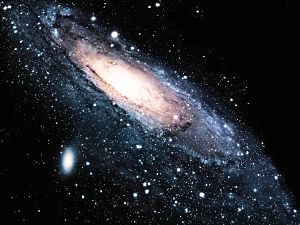By Mark Goldblatt
 “There is nothing new under the sun,” the author of Ecclesiastes assured us more than two millennia ago. Among the questions he glosses over, however, is how the sun got there in the first place. Which brings us to the Big Bang. In case you haven’t noticed, the origin of the world has been much in the news recently despite the fact, or perhaps because of the fact, that it’s the oldest story in the Book.
“There is nothing new under the sun,” the author of Ecclesiastes assured us more than two millennia ago. Among the questions he glosses over, however, is how the sun got there in the first place. Which brings us to the Big Bang. In case you haven’t noticed, the origin of the world has been much in the news recently despite the fact, or perhaps because of the fact, that it’s the oldest story in the Book.
It’s scientists who’ve been digging into creation of late, and doing so very publicly and very provocatively. This isn’t necessarily a good thing, either for science or for the rest of us, because the topic is an epistemological minefield and scientists are notoriously bad epistemologists, and, as a general rule, people who go digging in minefields tend to produce less than optimal outcomes.
The latest scientist to take on creation in a loud way is Neil deGrasse Tyson, host of the hit TV show Cosmos. In an interview with the Huffington Post, Tyson had this to say about the universe’s beginning:
“If you take the universe all the way back to the Big Bang, well, the entire universe was really small. So now you take the shotgun wedding – quantum physics and general relativity. In that shotgun wedding, if you follow through with all the predictions quantum physics gives you, it allows multiple bubbles to form – one of which is our universe. These are sorts of fluctuations in the quantum foam. Quantum physics fluctuates all the time. But now the fluctuations are not just particles coming into and out of existence, which happens all the time. It’s whole universes coming into and out of existence.”
You hardly know where to begin in addressing the errors in this passage. But let’s start with the idea of the “universe.” By definition, the universe is the totality of what was, what is, and what can be. It is, as the philosophers say, co-extensive with being. Whatever is possible, whatever is not a contradiction in terms, belongs to the universe. You and I are part of the universe. George Washington is part of the universe, despite the fact that he’s no longer with us. Even unicorns are part of the universe – although, as far as we know, they don’t actually exist. Real beings. Imaginary beings. Present beings. Past beings. If it’s an actual or potential being, if you can sensibly conjugate the verb “to be” in its vicinity, it’s part of the universe. Why? Because the whole purpose of a concept like “universe” is to encompass everything under one umbrella term—i.e., every thing.
You don’t have to fill up chalkboards with arcane mathematical formulae to know that there are no other universes; you just have to observe the prefix uni and to understand language. If there are other dimensions, or other modes of existence, past, present or future, they are – again, by definition – part of this universe, our universe. They are part of the world in its entirety, which is another way of saying they are part of the totality of what was, what is, and what can be.
But let’s be charitable to Tyson, who’s a scientist and not a philosopher, and who may not be acquainted with the ancient philosophical tradition of defining the universe as co-extensive with being. Let’s assume that when he talks about “whole universes coming into and out of existence,” all he means are those “bubbles” of matter and energy which lend themselves occasionally to detection and measurement – one of which we happen to inhabit (and which, mirabile dictu, is the only bubble we can currently detect and measure). Tyson insists that the existence of our world can be accounted for by the “shotgun wedding” of “quantum physics and general relativity.” How? By a “fluctuation in the quantum foam.”
Well, no.
If “quantum foam” exists, then matter and energy already exist. Hence, the universe already exists – even in the limited sense of the word “universe” that Tyson (again, to be charitable) intends. The question then becomes: How did that quantum foam come into existence? I don’t know how Tyson would answer that. I suppose he could say, Well, it was just always there. Except if he did, he’d be digging himself an even deeper philosophical hole. Because “always,” means “without a beginning” – which is another way of saying that an infinite amount of time has passed during which the quantum foam has existed.
You don’t want to go down that road, however, because you wind up knee deep in the problem of actual infinity. To be infinite, by definition, is to be unfinishable. Lots of things are potentially infinite – a line, for example, can potentially be extended infinitely in both directions. But you can never reach infinity. You can never make the potential actual. You never quite get to a point, as you’re extending the line, when you can kick back, have a beer, and say, “Okay, now at last the line is infinite.” You can’t finish what is, by definition, unfinishable.
Now think about time as a line going backwards. To say that an infinite amount of time has passed during which quantum foam has existed is to say that we’ve gotten to that point of infinity. Here we are, and past time is now infinite. We’ve finished the unfinishable. That’s what logicians call a contradiction in terms. If you’re forced to suppose the existence of a contradiction in terms – if, in other words, you’re forced to suppose that a thing is what it cannot be – you know you’ve gone wrong. It’s back to the drawing board.
(Around now is when some guy in the balcony who took differential calculus as an undergrad will usually shout down that infinity is used routinely by mathematicians…so why can’t something be actually infinite? It’s true that infinity is a handy mathematical concept, but it is used as an ideal limit, a value that can be approached but never reached. Sound familiar? Calculus Guy will usually be followed to the mike by Set Theory Guy, who’ll assert that the German mathematician Georg Cantor “proved” that sets with an infinite number of members exist. There are many flaws with Cantor’s work – too many to detail here – but suffice it to say that Cantor never spoke of an infinite set consisting of real objects like marbles or melons or moon orbits; rather, his infinite sets were always populated by abstractions – like the set of natural numbers, or the set of all sets. Indeed, Cantor himself acknowledged the distinction between, on the one hand, “reality” and “quantity,” and, on the other hand, “number” and “set.”)
But there’s an even more serious problem with Tyson’s statement: He’s implicitly rejecting the law of causality. He insists that whole universes – perhaps an infinite number of whole universes? – come into and out of existence all the time due to fluctuations in the quantum foam. But what causes the fluctuations? Tyson implies nothing does; the process just “happens all the time.” Here, he’s echoing Stephen Hawking, the world’s most famous living scientist, who in 2012 stated, “Spontaneous creation is the reason there is something rather than nothing, why the Universe exists, why we exist.” Weaving together the latest insights from string theory, gravitational theory and quantum theory, Hawking concluded, “The universe can and will create itself from nothing.”
Well, no.
If there’s nothing – to note only the most howling flaw in Hawking’s logic – if there’s literally no thing, then there’s no universe to create itself. (Hawking’s “nothing” is a more brutally illogical formulation than Tyson’s pre-existing “quantum foam.”) But even allowing that a miniscule speck of something, or some thing, ends up big-banging into the universe, you still have to account for that change from speck to world. A speck is what it is, and it will remain what it is, absent a causal force acting upon it; so says the law of causality. (The law of causality can be thought of as the law of conservation of identity.) Blaming the Big Bang on a quantum fluctuation gets you nowhere because you still need a cause for the fluctuation. The mathematical quirks of theoretical physics do not constitute exceptions to the laws of thought.
There are no exceptions, none whatsoever, to the laws of thought, including the law of causality. Nothing – literally, no thing – is exempted. No matter how distant. No matter how exotic. No matter how teensy-weensy. Not even the alleged topsy-turviness of quantum physics lets you wriggle free of them, despite what many contemporary scientists seem to think.
As I mentioned earlier, scientists, even brilliant ones like Tyson and Hawking, are often bad epistemologists. They tend to climb out on limbs and want to saw off the branches they’re sitting on. There is indeed a raging debate among scientists about whether causality holds in the quantum realm. So let me settle it for them: Yes, it holds. I say this with total confidence because their debate isn’t really about causality but about predictability – whether a complete mathematical description, if it were possible, of the conditions of a subatomic particle would allow an observer to predict the future state of that particle. The answer may well be no; there may be no possible mathematics to make such a prediction. But the fact that you’ve hit a mathematical dead end doesn’t mean that the change occurs uncaused; there is still some causal force behind it.
Mathematics describes forces but is not itself a force. If I drop a baseball down an elevator shaft, mathematical formulae can tell me where it will be and predict, with great accuracy, how it will behave at a given moment; but mathematical formulae are not causing the baseball to descend. Gravity is doing that. We may not know, and may never know, the exact nature of the force that governs the behavior of subatomic particles – call it the Quantum Fairy if you like – but there is a force operating on those particles, causing those probability equations to work out. There’s a force beyond the law of averages – which, again, is a mathematical description, not a causal agent – ensuring that order emerges out of apparent randomness. You can take that to the bank.
The irony is that scientists are more than happy to reason this way in other contexts. For example, they speculate that “dark matter” must exist to account for the state of the visible universe, and then go looking for it, because they know there must be a cause for every observable effect. Yet utter the word “quantum” and all bets are off. Ancient priests ridiculed the quest to find causal connections, invoking divine will as the solution to all mysteries – the so-called “God of the Gaps”; modern scientists echo them now with the “Quantum of the Gaps.” Can’t come up with a cause for subatomic behavior? No worries, that’s just quantum strangeness for you!
Except causality is science. It is the sine qua non of science. Having shimmied out on the limb of theoretical physics, scientists want to saw off the branch of causality that got them there. But the quantum realm isn’t a logic-free zone. “One cannot get around the assumption of reality,” Einstein wrote to Erwin Schrodinger in 1950, and reality is “independent of what is experimentally established.” Subatomic particles may be paradoxical little devils, fiendishly hard to pin down, but nothing about them rewrites the laws of thought. They are what they are, and they stay what they are, unless they are caused to change. If your equations force you to abandon your axioms, you’re screwed. It’s time to climb back down the tree and start over.
Which returns us, at last, to the reason we’re having this conversation in the first place: the Big Bang theory. On the one hand, scientists like Tyson and Hawking love the Big Bang theory because it provides an elegantly straightforward explanation for the existence of the universe, and because it seems borne out by more and more sophisticated experimental data. On the other hand, scientists like Tyson and Hawking hate the Big Bang theory because it points squarely to the first line of Genesis: “In the beginning, God created the heavens and the earth.” So desperate are they to avoid the slightest taint of religious sentiment that they’re willing to embrace literal absurdities – an actual infinitude, or an uncaused effect – to avoid the slippery slope back to the First Cause or Unmoved Mover favored by medieval theologians.
My message to Tyson and Hawking, therefore, is one of comity rather than enmity: C’mon in, boys. The water’s fine.
 Mark Goldblatt teaches religious history at Fashion Institute of Technology of the State University of New York. His two most recent books are “The Unrequited”, a literary mystery, and “Twerp”, a novel for young readers.
Mark Goldblatt teaches religious history at Fashion Institute of Technology of the State University of New York. His two most recent books are “The Unrequited”, a literary mystery, and “Twerp”, a novel for young readers.











